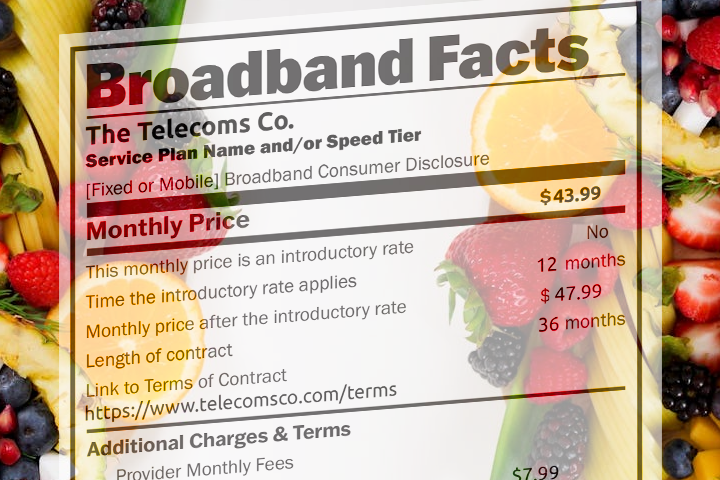Can broadband “nutrition labels” make connectivity more digestible for customers?

The FCC now requires service providers in the US to slap “nutrition labels” on their fixed and wireless plans to stop customers gorging themselves on bad broadband. Will this move create a healthy market for customers, or leave a bad taste?
From this month, under new FCC rules, internet providers in the US will be required to publish broadband “nutrition labels” that explain prices and terms for all of their fixed and wireless plans.
The new broadband labels are designed to package and provide already-available information about the costs of all fixed or wireless plans offered by CSPs into a single, easy-to-understand summary.
The broadband labels must be readily available for customers to view when purchasing online or at physical stores. If there are any changes to plans, the labels must be updated accordingly.
These labels must include:
- The monthly price of the plan, including any introductory rates
- Additional monthly or one-off fees, such as handset payments
- Any early termination fees
- Discounts or bundles available
- “Typical” upload and download speeds
- Data included in the monthly price, in GBs
As part of the telecoms reforms of 2021’s Infrastructure Investment and Jobs Act, all CSPs with over 100,000 customers must, as of 10th April, label every package of theirs, while smaller providers have until 10th October to comply.
Readers from the US (or those partial to an imported box of Twinkies) will find these labels familiar, as they’re modelled on the nutrition labels required by the Food and Drugs Administration (FDA) on all packaged foodstuffs.
Though the nutrition facts label only debuted in 1994, The New York Times has called it “the most printed and viewed piece of literature, piece of art, in the world,” while Italian designer Massimo Vignelli called it “a statement of social responsibility, and a masterpiece of graphic design.”
Designed to be bold and unambiguous, its versatility allows the format to be updated to reflect “the changing landscape of nutritional knowledge,” most recently updated in 2021 to include measures for sodium, vitamin D and fibre (not of the optical kind, but the cereal kind).
Now, the FCC is hoping that similar labels will solve many of the same issues for the telecoms sector – above all, the need to help a largely uninformed consumer base make informed decisions about purchases, but also to address the rise in pre-packaged products with confusing “ingredients,” and the tide of misleading claims.
Will the broadband labels work in the same way as their nutritional predecessors?
Well, they’re instead replicating many of the shortcomings of food labelling. Looking at health outcomes over the last few decades, it’s hard to argue that greater access to nutrition information has made an impact:
Reportedly, only 5% of consumers read nutrition labels when making purchases, despite them being printed on the packaging, and the benefits of this labelling in a nutritional context remain “mixed and inconclusive.”
Despite the requirement that these new broadband labels be clearly promoted, there’s no specification as to where they’re placed – go on any CSP’s website currently, and you’ll struggle to find these labels without already knowing about them.
Ambiguous terminology or wording can further compound this, leading consumers to believe certain features are better than they are. We can see this on the broadband labels and their “typical” upload or download speeds, which are likely to differ significantly from real-world speeds.
And what happens if customers find their advertised speeds to be inaccurate? The FCC is relying on consumers themselves to police the accuracy of labels and lodge complaints, and there’s no requirement or mechanism for CSPs themselves to have their labels approved by the regulator prior to publication.
And how many labels would they have to get approved, if they did? AT&T predicted that the company would have to create over 29,000 labels just to cover various state-by-state fees. For smaller telcos, once the October deadline passes, this could create a mountain of new regulatory work.
It is essential for consumers to understand what they’re getting from their connectivity services. However, much of this information is already largely accessible. Instead, these labels could have been used to offer more transparency as to the reliability of broadband or phone services, indications of how user data is handled, or the environmental impact of their networks.
Nevertheless, broadband labels go some way towards making confusing or hidden price increases more obvious to consumers, and that can only be a good thing.
